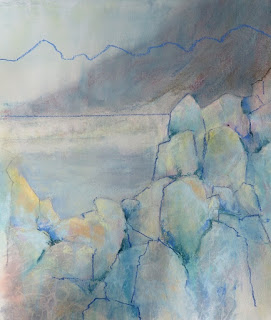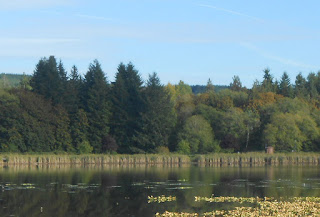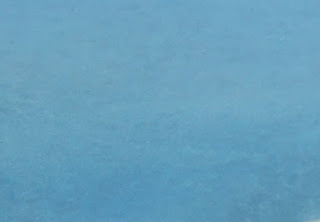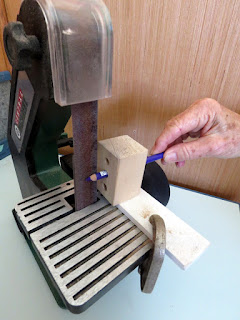Fall color is so inspiring; the artist within me can not leave it alone.
In attempting to capture the beautiful colors on display in the fall, I found myself getting way to heavy with my foliage. I guess this comes from wanting to emphasize and communicate fall color to the viewer.
This one is more successful: a rendering of a cottonwood tree decked out in in fall foliage. I was able to keep the feeling of light-weight foliage supported by this fast growing tree.
The first image is of the tree alone and gives you a chance to focus on my method of how the leaves were applied.
Over a watercolor underpainting, I scumbled my pastel sticks in shades of yellow and warm browns purposely using a light touch and leaving plenty of the background color showing through.
The second image is a more complete painting. I really enjoyed working in the background with the contrasting colors of lavender and blue. I felt this helped bring the tree forward while creating some more interest in the painting as a whole. The limited pallet worked very well.
Tuesday, December 20, 2016
Sunday, November 6, 2016
Painting Spruce Trees
Alaskan Spruce Trees offer an exciting challenge especially when developed over a watercolor underpainting. The trees can be suggested with pastel sticks but the trick is to keep them simple and not overworked. At the same time one must use different values (layers of pastel) to give the trees recognizable identity.
Spruce Trees on the Gastineau Channel
Watercolor underpainting in warm yellows was applied to the land mass area and where the trees would be developed. Using three different values of pastel the trees were developed increasing the value and intensity of the color in the closer trees and allowing the background trees to remain a lighter, cooler color.
The color of the water was also executed in the initial watercolor underpainting stage of the painting. Reflections were strengthen with pastel.
The entire painting has a misty, ethereal feel so typical of the Alaskan landscape.
Alaskan Spruce Forest
The approach to this painting was much the same as the previous painting but the watercolor underpainting was done with cadmium scarlet, permanent rose and cobalt blue. Care was taken that the red and scarlet colors were laid in the area designated for the forest. Some of the cobalt blue was allowed to mix with the scarlet to produce lavender to suggest distance.
The distant trees were painted with light grayed green. Warmer greens and stronger values were used as the trees move forward.
Again, care was taken to avoid overworking the trees, suggesting shape and growth rather than a detailed rendering.
Tuesday, October 18, 2016
New in the Studio
I am enjoying working with Nu-pastel sticks and have recently increased my supply. The narrow, square sticks encourage me to make angular, directional strokes giving an energy to my painting that I was not able to achieve with the soft, rounded pastels. I also find that I have more control and can see what I am producing better.
Here you can see the Nu-pastel sticks grouped
according to warm and cool colors.
Friday, October 7, 2016
Painting Glacier Faces with Watercolor/Pastel
Glaciers are awe inspiring. They are so huge, cold, exhibiting a silent, creeping power. The glacier is not just white ice but radiates colors of blues, greens, oranges and pinks. So much to study and communicate with my paints.
Here are a series of glacier faces I have rendered using the watercolor/pastel technique that is demonstrated in this blog.
This was my first attempt.
For the watercolor underpainting I used viridian green, aureolin yellow, cadmium scarlet and cobalt blue.
I secured the top edge of the glacier by developing a mountain behind using soft pastels.
Pastel was also added to the sky area to create a misty atmosphere, blending it
into the mountain edge.
Only a minimum amount of pastel was applied to the glacier face.
Perhaps my ice would be more credible if I placed in into a glacier-environment: Mountains, water and a second glacier in the distance.
I did not find this composition satisfactory, so . . . . .

I redesigned it!
One of the great things about working with pastel is that it can be reworked I removed the pastel from the top of the painting, first with bristle brush and then with a kneaded eraser.
I then added a mountain contour and a water line.
Here is the finished painting.
The snow covered Alaskan range identifies the location. The soft, cool colors make the viewer think "ice".
Notice all the color in the mass of ice. Glaciers are not simply white ice.
This rendering is done in a horizontal format.
I originally thought that a vertical format would be the best choice to communicate the glacial ice.
I am glad to have tried the horizontal format because to my eyes it represents the massiveness of the glacier better.
Here are a series of glacier faces I have rendered using the watercolor/pastel technique that is demonstrated in this blog.
This was my first attempt.
For the watercolor underpainting I used viridian green, aureolin yellow, cadmium scarlet and cobalt blue.
I secured the top edge of the glacier by developing a mountain behind using soft pastels.
Pastel was also added to the sky area to create a misty atmosphere, blending it
into the mountain edge.
Only a minimum amount of pastel was applied to the glacier face.
Working more detail in this glacier face I secured the top edge of the ice with muted pastels of dark green, violet and gray.
The base of the glacier is defined by the water also executed with pastel.
Perhaps my ice would be more credible if I placed in into a glacier-environment: Mountains, water and a second glacier in the distance.
I did not find this composition satisfactory, so . . . . .

I redesigned it!
One of the great things about working with pastel is that it can be reworked I removed the pastel from the top of the painting, first with bristle brush and then with a kneaded eraser.
I then added a mountain contour and a water line.
Here is the finished painting.
The snow covered Alaskan range identifies the location. The soft, cool colors make the viewer think "ice".
Notice all the color in the mass of ice. Glaciers are not simply white ice.
This rendering is done in a horizontal format.
I originally thought that a vertical format would be the best choice to communicate the glacial ice.
I am glad to have tried the horizontal format because to my eyes it represents the massiveness of the glacier better.
Saturday, September 10, 2016
Painting Alaska
Returning from a wonderful trip to Alaska filled with new subject ideas I just had to use my watercolor/pastel technique on the icy Pacific Glacier.
Alaska landscape opened my eyes to a new pallet of colors. The atmosphere and summer lighting was inspiring. The powerful, majestic Alaska range was calling to be painted.
Pacific Glacier, Glacier Bay, Alaska
Watercolor Underpainting
Bold, cool colors to suggest the ice and snow were laid down
on a sheet of wet watercolor paper (Hot Press 140#).
Painting in Progress
Using soft pastels the mountains and glacier were developed.
Cool blues and violets tempered with some warm brown were used
to create the texture.
Finished Painting
Pacific Glacier, Glacier Bay, Alaska
Securing the mountains with pastel in the sky area,
tightening up edges, defining the water line
and detailing the glacier brought the painting to completion.
Wednesday, August 3, 2016
Now that we have thought about representing trees in watercolor/pastel, let's look at applying what we know.
Note the green, white and yellow shapes on the right hand edge of the tree.
By using lavender pastel and working around the light shapes the tree takes shape and form.
Pastel Drawing over Watercolor Underpainting
When underpainting is thoroughly dry begin drawing your subject with pastel.
Bold Underpainting
Underpainting can be bold and abstract. Think about your subject as you apply the watercolor. In this case I am concerned to suggest the direction of growth, their posture and position of the tree to be drawn on the page. I want to select colors that will complement my foliage color. I am concerned to establish rhythm and balance. I keep my final idea in mind but am not dictated by it.
When the underpainting is dry, I can superimpose a finished image over the underpainting being careful to leave some of the underpainting color alone and free from pastel.
Applying Foliage
Let's take a closer look at the application of pastel to represent foliage.
Here is a watercolor/pastel study of a massive oak tree that shades my patio.
Take a closer look at the foliage.
I have used a scumbling technique to create texture. I have softened some edges. But look how vibrant the areas are where I allow the watercolor color underpainting to remain untouched. The transparency of the watercolor allows the "white" of the paper to glow through.
Outside edges can be secured with pastel. This is especially useful for light value edges that were created with watercolor during the underpainting stage .
By using lavender pastel and working around the light shapes the tree takes shape and form.
The same technique can be used to secure the lightest side of trunks and branches. The light areas on the trunks of these trees have no pastel on them. Their value and color is established with the watercolor underpainting which was applied at the beginning of the painting.
Tuesday, June 21, 2016
Study Trees
Let me share some things I have discovered by studying trees.
Trees in the distance can easily be identified by their shape.
By their silhouette we recognize them.
So draw a the tree's shape to communicate its identity.
So draw a the tree's shape to communicate its identity.
In addition to being cognizant of a tree's shape, we
also need to consider its direction of growth, it's gesture and
its personality. Yes, trees have personality or at least they suggest certainly personality traits. A tree can be strong and
resilient like an oak or delicate and lyrical like a willow tree. Also
remember, a tree is alive, growing
upward to catch the sunlight's energy.
Look for the tree's personality.
Strong Graceful Stately
Keep this in mind as you draw your tree.
It will help you represent the distinct character of your tree.
As you study your tree, note the dark and light shapes.
These give your tree form.
Shadows falling on a tree trunk give form and shape to the trunk.
Note how the shadows follow the contour of the trunk.
Trees cast beautiful shadows on the ground that echo their limbs and
foliage.
About green trees. The foliage that we read as "green"
is really made up of several different hues.
More about greens in a future post.
Juxtaposition yellows
and blues to produce the illusion of green.
Note how tooth of your paper can work to create texture for tree foliage.
The paper's tooth produces texture for rendering bark.
Study trees wherever you go.
Take lots of pictures to bring home to study at your leisure. Use your sketch book to note and study the
nature and character of the tree, its value patterns and habits of growth. Indicate
the light and dark areas in the foliage that give it form. Remember, a tree is not flat.
Friday, June 10, 2016
Trees - Watercolor/Pastel
A landscape painter needs to be competent in executing
trees. Distant trees are fairly easy to depict. They
can be recognized by their silhouettes.
Simple identifiable shapes form rows of pine trees.
The challenge is when the tree is your subject or needs to be a part of your foreground. I have spent many hours drawing and painting trees and still feel I have more to learn. Here a some generalizations to consider:
Observe the shape of the tree. The shape of the tree helps to identify the species. Draw the contour of the tree true to its
shape.
As you observe and draw the foliage think united masses of
leaves, some in the foremost part, some receding to the back part of the tree.
This tree has three large masses of foliage.
Within the larger masses there are smaller ones.
Use at least three greens of different values when painting
"green" foliage.
Soften some edges; leave some crisp.
Keep foliage light
and trunk and branches strong. The skeleton of the
tree must support the weight of its foliage.
Friday, May 27, 2016
My Basic Method
We have looked at tools
and materials. Now let's see how we can
use them to create a painting that makes use of the best of both mediums: watercolor
and soft pastel
You might want to try this
subject just to get started, but the procedure is much the same with any
subject.
On watercolor or mixed
media paper create some loose beautiful watercolor washes on a wet sheet applying
the colors you wish to use. They should
be different than the color you will use for your subject to create surface
interest and more color excitement.
Keep your final subject in mind but be free with your color.
Note that I chose Aureolian
Yellow and Permanent Rose for the underpainting knowing that my
subject would be completed in shades of green.
Aureolian Yellow and Permanent Rose blend together on the
wet paper to produce a beautiful scarlet.
The yellow gives warmth and the rose gives contrast.
When the watercolor washes
are dry, indicate your main shapes with pencil.
Note: I have used a dark
pencil so you can see the drawn shapes in the photo. Use a light pencil for your work; it is only
to be a guide.
I have chosen to leave the
sky area alone, so I will work on the band of ocean next. Working from the top to the bottom helps to
keep the work clean. And remember we
want to stay out of any areas of watercolor we want to remain clean and
vibrant. Choosing three values of color
I apply them to the ocean shape, grading the color as I work towards the line
of vegetation on the land. Blend this
area keeping out of the other areas (tree and shrub). Use your favorite blending tool for tight
spots.
To keep a clean edge at the
horizon, use an eraser shield as you
blend the colors into the paper.
Next is the line of
vegetation. Use three different values
of muted greens and scumble the pastel stick so as to allow some of the
underpainting and texture of the paper to remain. Soften some of it if you
like.
Note how the watercolor underpainting glows through the vegetation.
Next, tackle the tree shape. Think: direction of growth. Use minimal strokes. Leave some of the underpainting showing
through.
Again, use three different values, blending where foliage is dense.
I think you can finish the
rest with no more specific directions.
Just remember that your lightest areas are created by the watercolor and
the pastel is used only to clarify the subject and act as a strong contrast to
the watercolor.
Thursday, May 26, 2016
Surfaces to Use with Watercolor-Pastel
I have experimented with
may different surfaces searching for the best support for both pastel and
watercolor.
Rag watercolor paper offers
the most transparent, glowing washes but is somewhat fragile for pastel work
when much reworking or blending is needed.
Watercolor paper with
tooth can produce too much overall texture
when pastel is applied. This is
especially disturbing when the paper in question has a mechanical texture.
Some of the smooth
watercolor paper (hot press) does not always offer enough tooth to hold the
pastel.
It was difficult to get
enough color into the sky area
on the smooth surfaced paper.
The two papers that have
given me the most success are:
Strathmore Mixed Media
paper (easily found and inexpensive):
This paper does not offer the brilliance achieved with rag watercolor
paper but it is very sturdy and can survive much reworking. It also does not have a lot of
"tooth" but is sufficient for several applications of pastel. A good choice if you are exploring a subject .
Close-up of trees behind houses.
Arches Hot Press (archival
quality): Produces beautiful washes and
will support pastel application if not overworked. Plan ahead for those areas where you want to retain
the transparent watercolor washes. Then
stay out of them. You will never regain
the transparent quality once you have introduced pastel into an area. Fixing a lost "white" with a very
light value pastel never results in the same effect as to leave the watercolor
standing by itself.
Note the brilliance of the
golden sand (undisturbed watercolor wash)
contrasted with the solid vegetation
(pastel).
Monday, May 23, 2016
Some Tools to Use with Pastels
As I began to work with
pastels I soon became aware of some challenges I had not met when working with
watercolor.
For one, pastels are
messy! Dust collects and smudges
occur. How to cope. I found it helpful to have several
terry-cloth rags and replacing them frequently; used as a bed for the pastel
sticks I am currently using and for cleaning up pastel dust. Also a small portable vacuum has been helpful
and wet-mopping my linoleum floor is a necessity.
When working on the pastel
drawing I try to begin at the top working downward to avoid smearing the
pastel. I also often will cover the
lower half of my painting with a sheet of layout paper.
Pastels can be reworked. Some of my favorite tools for blending and reworking:
- Kneaded erasers both for removing and blending.
- A bristle brush for blending. The long handle keeps my hand away from the paper surface and I can see where I am working.
- The old fashioned pastel paper wipes are great for blending. Did you know you can sharpen them? More about sharpening later.
- There are some tools used in clay work with different sized tips that can be used to move pasted and control the edges. Also there is a tool called a Colour Shaper that is used to move paint around and can be used to move pastel, Visit your local art store and browse the items; use your imagination. It is fun to try different possibilities.
- My most frequently used tools for blending are my fingertips. Best control as to direction and pressure.
Pastels come in several
different sizes and hardness. Have a
variety within your reach to meet your need.
Pastel pencils are great for detail.
Try to keep from dropping them on the floor; the soft pastel encased in
the wood breaks easily.
And how to keep
them sharp? I have tried lots of
sharpeners, hand and electric, knives and razor blades and am happiest with a
small belt-sander. It is quick and gives
a great point to your pencil or paper blending tool.
There are some fine sources of information covering pastel
materials, tools and techniques.
Visit Deborah Secor at: http://landscapesinpastel.blogspot.com/
Monday, May 16, 2016
Working with Pastels
Since my goal is to combine
watercolor and pastel in a harmonious relationship, each contributing its
strongest attributes let's take a minute to reflect on what makes relationship
work.
For a marriage to be successful the
partners need to know each other well.
So is it when uniting watercolor and pastel. Actually it is you the artist who needs to be
well acquainted with the participants (the tools you will use). To be successful you must be proficient in
both mediums. For a marriage to be
successful it takes application and practice.
So you need to be patient and persevere as you explore and practice.
Having successfully pursued
watercolor for 22 years as a professional artist and teacher I feel confident
with watercolor techniques. But soft pastels
are a new medium for me. It has taken
many hours of exploration with various materials and just good old fashion
practice to become secure with pastel. The purpose of this blog is to share
with you the techniques and insights I have gained. Perhaps you will want to
give this marriage between watercolor and pastel a try.
To become acquainted with pastels I
have done some flower studies on different surfaces.
Pastel on Drawing Paper
Pastel on Dark Paper
Using the Color of the Paper to Develop the Subject
Pastel on Sandpaper
The pastel really bites into the surface.
I also spent some time working out a system of organizing my
pastel sticks. The one illustrated here
(see photo below) seems to work best for me.
I select the colors
and values I want to use from my compartmental trays and lay them out on a
terry-cloth towel. This helps me stay
focused on the colors initially chosen and keeps me from introducing too many
colors or discordant color.
My next step was to explore tools that would help me in the
execution of pastels.
Subscribe to:
Comments (Atom)



















































